Amalie Robert Estate Climate Update: 2016 June
Hello and Welcome,
This is the June 2016 Climate Update from Amalie Robert Estate.
June started out with scorching hot temperatures approaching the century mark and ended the month with a fair shot of rain followed by cooling breezes from the north. As they say “A fast horse don’t run long…”
So, what have we here with this 2016 growing season? So far, the season started off lickety split with a very warm to hot April. May was more in line with the past few vintages, which were also warm, and now June seems to be running out of steam. Based on the flowering date of May 27th plus 105 days, we see a harvest window opening up in mid to late September. That means we have about 75 days of growing season left before the Great Cluster Pluck of 2016 visits itself upon us. But wait for it, and some vintage extending rain, we will.
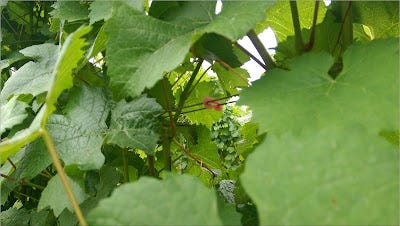
The month of June is when the crew finished straightening up all of the shoots and clipping the catch wires into place.
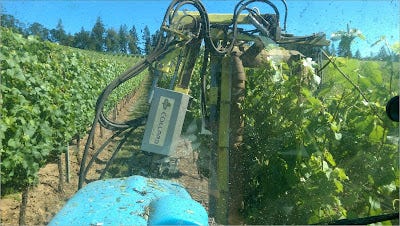
That’s when Ernie was finally able to arrest the expletive growth in the canopy. Note: The early season soil moisture and above average heat are two things the vines picked up on RFN (Right Farmin’ Now.) The hedger, aka “The Enforcer,” is the correct tool for the job. With 5 sets of blades spinning at warp 8, Ernie and The Enforcer will not be denied.

It takes him 3 days to make a single pass through the vineyard, but he does mow up the trimmings as he goes. The first hedge is always the most dramatic. The hedged shoots take about a week to ten days before they start to push new shoot tips. This timeframe gives all the shorter shoots that missed out on the first hedging a chance to grow into the “Red Zone.” Then he is back for the second pass.


The hedgings will continue until canopy discipline improves!
And then, suddenly, as if by the sweat of everyone’s collective brow, we are almost caught up. Through this point of the growing season, we have done what had to be done to get the canopy trained and hedged. But now with leaf pulling, we get to do what we want to do. We find ourselves in the winemaker’s role of determining how much skin tannin we want in our wines.
Pulling more leaves means more wine berry exposure and more robust tannins. Pulling fewer leaves means less sun exposure resulting in more elegant and refined tannins. The discretionary role of leaf pull is where the art of winegrowing takes a “leaf” in destiny.
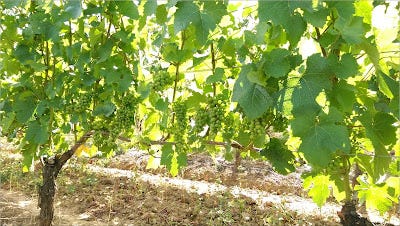
Practically speaking, the choices lay somewhere between completely denuding the vine of its shade providing leaves or to retain all the leaves and provide abundant shade to the wine berries. Depending on the wine and wine style we are producing, we vacillate widely between the two.
And as we all know, it is a very fine and vacillating line between genius and insanity. Which side you come down on is often determined after the fact and dependant, at least to some extent, upon your ARB quotient (Adult Recreational Beverage consumption per hour over body weight.)

Now if we look at the available statistics, we see that wine reviewers also vary widely in their interpretation of genius and insanity. A case in point is our wonderfully expressive 2012 Dijon Clones Pinot Noir. Personally stewarded through the winegrowing, blending and bottling process, we see a Vinous score of 93 points and a Wine Advocate score of 86 points. Within the microcosm of Pinot Noir wine scores, this range represents nearly the full spectrum. While the statistical comparative computations are an exercise left to the reader, we can assure you that this represents more than a couple standard deviations. Waft The Fruit.
And not to put too fine a point on it, but it is worth pointing out that there is a difference between 17 years of experience, and one year of experience 17 times. Ah, the beauty of vintage variation in Oregon’s Willamette Valley.
We just look at each other, toast with an ARB and remember that this is why there all kinds of different dogs for all kinds of different people. One person’s “Best in Show” at the Westminster Kennel Club Dog Show is another person’s padoodle. Full disclosure: We do have a dog in the fight. Ernie’s favorite breed, the Labrador Retriever, has neverwon best of show since the show’s inception in Manhattan, New Yorkin 1877. That, and look how much money we will save in not having to ship our wines to Londonfor a third time. Wit of a banker, so they say. We will, however, continue to FLOG them until they say they have had enough. Shouldn’t be too much longer now…
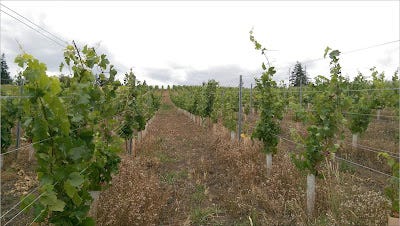
Please say Hello to our new vines! Wadenswil clone Pinot Noir they are. We finally received our line posts up from California. It seems they were stuck in the Port of Los Angeles for a good (long) time. And of course the time to pound them would have been a wet spring, not a dry summer, but we are farmers first, and endeavor to persevere we do. While it will be some time before their first vintage is under cork, they are busy putting down character building dry farmed roots. First things first.
And the Swallows have arrived. These voracious insectivores are some of the most aerially talented flyers we have in the vineyard. They frequently are crisscrossing and darting in front of the tractor as Ernie is driving the rows. They are harvesting insects that are attracted to the flowering buckwheat summer cover crop. An ecosystem at work is a wonderful thing to behold.
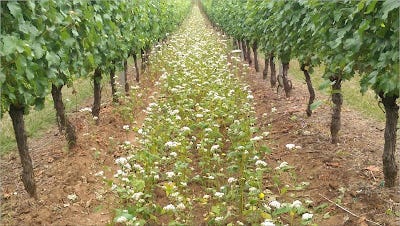
Across the pond in Europe, and the now recently disassociated UK, they have the Common House Martin. Soccer is also a big deal on the other side of the pond, just ask anyone from Iceland. Perhaps Operation Fork is still an unresolved issue, or maybe the Cod Wars…

Bonus Feature: This is the last known resting place of the Crimson Permanent Assurance. (Hint: Click on the picture.)
Next up is the prospect of thinning the crop load to match the remainder of the growing season. If it is going to be hot, we leave a few extra clusters. If it is going to be more moderate with a cool fall, then we thin off a few more clusters. If we only knew…
Just like playing chicken, the important thing here is to know when to blink. Because, you see, once you cut the clusters off, you can’t put them back on. And it seems the wings that we used to thin off and drop onto the ground have found a home.
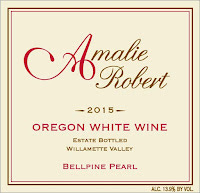
The Bellpine Pearl has been a well received wine, so it is looking like there will be a 2016 offering. The “Pearl” is a Blanc de Noir still white wine made from the late to ripen wings of Pinot Meunier and Pinot Noir. Bellpine is the name given to our sedimentary soil series and the Bellpine Pearl is our pearl from the soil or “Pearl de Bellpine.”
Well that about does it, except for the important numbers. The good news is that the growing season to date degree day accumulation through June is still just 3 digits. We fully expect the July growing season to date accumulation to take us well into the 4 digit range. “Mr. Sulu, scan long range sensors…”
The month of June recorded 363.1 degree days providing an April to date growing season total of 805.1 degree days. We remain climactically ahead of all previous degree day accumulations dating back to 2003. But the 2015 vintage is not far behind at 799.1 degree days. A mere 6.0 points (not 7.0) separates these two vintages as of the end of June. Statistically, we could say they are not significantly different when you consider standard deviations and all…

Looking ahead, the evening temperatures will be the elephant in the room. Warm temperatures at night will increase the rate of sugar accumulation while leaving aroma and flavor development wanting. This could mean another early harvest to keep the potential alcohol below 15%.

However, at Amalie Robert Estate we can tell you the secret to vintage 2016 (and the last 4 vintages) is to manage the canopy and vineyard floor water usage. How you actually do that is very site specific. Old vines with deep roots and grizzled growers with several years experience are quintessential. May want to put the kettle on, Polly.
And what is it with the hail this year? We were pelted again this month with those frosty little pellets. It’s as if someone is raising rabbits in the Heavens. Which reminds us of the old adage: “If pigs could fly it would have had a significant and long lasting impact on the fedoraindustry.” The homburgs, however, were “built to take it.”
All that aside, or above, we logged 1.33 inches of rain for the month of June. This brings the April to date growing season total to 5.24 inches. July is on the horizon and typically is quite dry in the Willamette Valley, unlike Burgundywhich seems to log about 50 centimeters of rain during July – they measure things differently over there. More on the contrast of summer rains in Oregon v Burgundynext month.
Right. You have just been FLOG’d, whether you knew it or not. And we are going to do it again. But please, feel free to forward this on and “FLOG a friend!”
Kindest Regards,
Dena & Ernie



